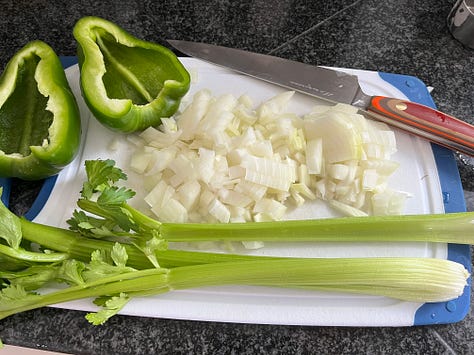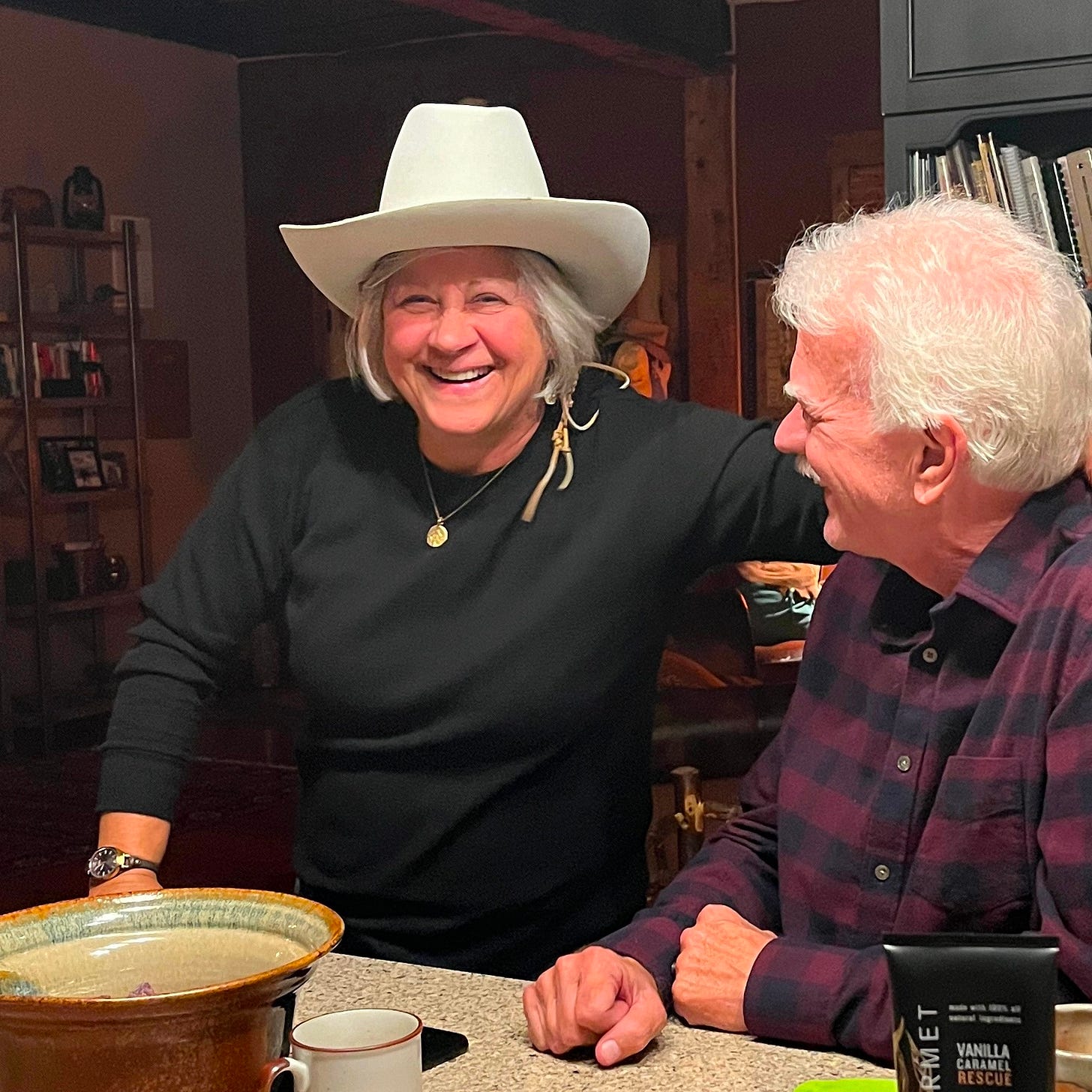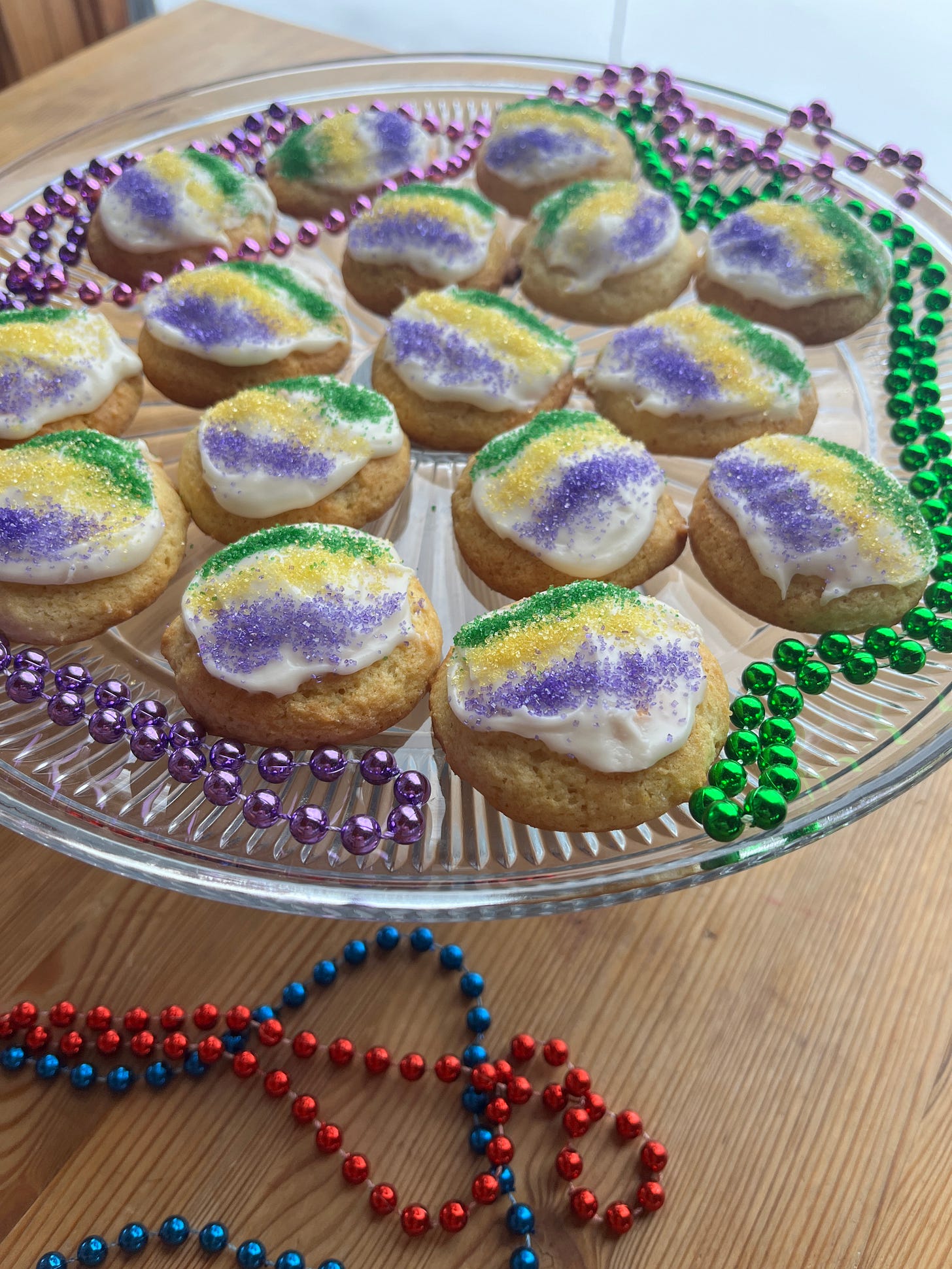Mardi Gras Highlights
Mini King Cake Cookies and Major Gumbo
March 4th was a propitious day for the family. Iris marched forth into the playschool with her brother, gladly leaving behind her babyhood. Maybe she was bored spending her days with two grandparents. She did not shed a tear when her dad dropped her off; just went boldly forward to make friends and influence people. She is out in the world now, one of the gang.


Last night, we had a little Mardi Gras celebration with our friend Kim from Minnesota. Kim is an Olympic speed skater who attended the 1980 Olympics at Lake Placid. She and John had much to discuss—Is Eric Heiden a nice guy? Did all the Russians wear fur hats? What was it like when the US beat the Russians?—since they were both there.
Last week’s post had a photo of the gumbo recipe I planned to make, and now here is what I did to it. I could not get fresh okra in Alpine or Jackson, so I used frozen, which was just okay. And I swapped out ham for shrimp in the recipe, including the Andouille, and just some of the chicken from the stock step. It was a lot—and it was good with white rice on top and a sprinkle of file powder, which makes a big difference to me. Filé is powdered from sassafras bark, and it serves to thicken up the dish and lend an earthy, woodsy flavor. It is widely available in grocery stores under the Zatarain brand.



What is critical when you are making gumbo is to seriously brown the flour in making the roux, like for 30 to 40 minutes. That browning inhibits the thickening ability of the flour, which is why okra, and to a lesser extent, filé, is added. I like to put a scoop of rice on top of the gumbo, which also helps to thicken, but I keep the rice separate when I store the leftovers so the rice doesn’t swell up and soak up all the delicious broth.
Creole Chicken, Sausage, and Shrimp Gumbo
Serves 10
1/3 cup neutral oil (I used grapeseed)
½ cup AP flour
1 large onion, diced
1 large green pepper, seeded and diced
4 stalks of celery, diced
1 pound okra, sliced (frozen is fine but fresh is way better)
1 bunch scallions, chopped
3 large cloves garlic, minced
1 teaspoon Herbes de Provence
1 tablespoon minced fresh thyme
16-ounce can of petite diced tomatoes
4 quarts of homemade chicken stock
Salt and pepper to taste
1 pound Andouille sausage, sliced
1 pound shrimp, peeled and deveined
1 pound chicken, cut-up, from the stock
White rice, cooked according to package directions
Filé powder
First, make the chicken stock, using this recipe or your own. When the stock is finished, remove the meat from the bones and weigh out one pound, reserving the rest for another use.
Start the roux, adding the oil to a large pot and getting it hot before you add the flour. Cook over medium low heat until a rich dark brown. While the roux is cooking, prepare the rest of your ingredients and set up your mise en place.
When the roux is truly dark enough, add the onion, pepper, and celery and saute for a few minutes. Add the sliced okra and cook until all the stringiness disappears. Fresh okra will require more cooking time than frozen, which is already cooked.
After the stringiness disappears, add the scallions, the garlic, and the seasonings and cook for a few minutes. Add the tomatoes and pour on the stock and allow the mixture to simmer. Taste for seasoning and add salt and pepper if necessary. How much will depend on how seasoned your stock is.
You can do that much the day before. Shortly before you want to serve the gumbo, cook white rice according to package directions. I used two cups of rice and had plenty for this amount of gumbo. Cook the Andouille in a dry cast-iron pan until it is browned. Remove and add to the gumbo. Cook the shrimp in the same pan as the sausage, using the fat rendered from the sausage.
Just before serving, add the shrimp and the chicken to the gumbo, bring it up to a boil, and serve with a scoop of white rice on top, dusted with filé powder. Serve filé powder at the table and Tabasco sauce for anyone wanting to spice it up.
We had a salad with dinner, just greens lightly dressed with oil and vinegar and topped with toasted pine nuts, frizzled prosciutto, and Parmesan cheese. Kim brought a crusty baguette from her trip to Jackson that afternoon, and we enjoyed a nice Belleruche Cote du Rhone with the dinner.
Dessert was a spin-off on my sister’s King Cake cupcakes—King Cake cookies! It was a soft, lemony cookie, spread with a bit of frosting and topped with the New Orleans Mardi Gras colored sanding sugar—purple, gold, and green. No babies to break your tooth on.
King Cake Cookies
Based on a recipe for Italian Ricotta Cookies from the New York Times
Makes 48 small cookies
4 ounces unsalted butter, softened, plus one tablespoon for the icing
1 cup granulated sugar
1 cup ricotta cheese
Lemon zest from half a lemon
2 teaspoons vanilla (divided)
1 egg
2 cups flour
1 teaspoon baking soda
2 cups confectioners’ sugar
The juice of that half of a lemon that you zested
1-2 tablespoons half and half or milk
Purple, gold, and green sanding sugar (found in the baking aisle at our local Broulim’s)
Cream the butter with 1 cup of sugar until fluffy. Add the ricotta, the lemon zest, one teaspoon vanilla and beat to incorporate. Add the egg and then the flour, baking soda and salt. Cover the dough (it will be very soft) and chill in refrigerator or freezer until firm enough to shape.
Heat oven to 350°F and prepare two baking sheets by lining them with parchment paper. Scoop out the dough with a #60 scoop or a tablespoon and place the dough balls on the paper two inches apart. Bake about 12-15 minutes, until the cookies are golden brown on the bottom. Cool on a wire rack.
Melt the remaining one tablespoon of butter and whisk in the confectioners’ sugar until it is nice and smooth. Add the juice of that half lemon you zested, the other teaspoon of vanilla, and enough half and half or milk to make the icing spreadable.
Spread the icing on the cooled cookies and sprinkle on the colored sugar to decorate.
It was a fun Mardi Gras feast; we all behaved ourselves and didn’t wear the beads. We listened to zydeco music, gabbed, and counted our blessings going into the Lenten season. As they say in NOLA, “Laissez les bons temps rouler!” We were happy to be healthy and hungry again.






